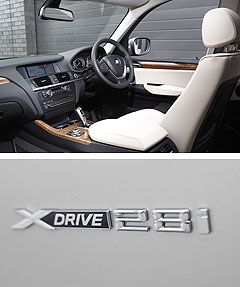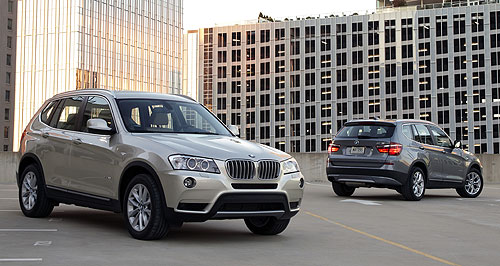Make / Model Search
New models - BMW - X3 - xDrive28iBMW drops X3 inline-sixHit for Six: The BMW X3 no longer comes with a six-cylinder petrol engine, instead getting a punchier turbo-four. TwinPower four-cylinder turbo-petrol replaces inline-six in BMW X3 xDrive 28i7 May 2012 BMW Australia has dropped the six-cylinder petrol engine from its X3 xDrive28i and replaced it with a faster, pricier and more frugal turbocharged four-cylinder unit while retaining the same badges. The addition of the new engine – already found in the Z4 roadster, 3 Series and 5 Series sedans, and possibly the smaller X1 later this year – means the popular premium SUV range is now all-turbo. While power output is down (180kW compared to 190kW for the inline-six), torque is up by 40Nm to 350Nm between 1250 and 4800rpm, while 0-100km/h acceleration is two-tenths of a second faster at 6.7 seconds. As before, the 28i is matched to a standard eight-speed automatic transmission with Steptronic manual mode. Like the rest of the engine range, the xDrive28i now comes with a fuel-saving idle-stop function, which helps bring claimed petrol consumption down by a substantial 1.5 litres per 100km to 7.5L/100km. Carbon dioxide emissions are reduced to a claimed 175 grams per kilometre – giving the 28i identical economy and CO2 figures to the xDrive20i with a less powerful version of the same engine. The new xDrive28i is priced from $72,900 plus on-road costs, an increase of $1000. This price hike also applies to the flagship xDrive30d, which now costs $75,900. Entry-level xDrive20i petrol and xDrive20d diesel variants also cop price rises – up by $300 to $59,500 and $62,500 respectively.  To counterbalance these price increases, BMW has made satellite-navigation – previously a $2000 option – a standard feature on both xDrive28i and xDrive30d variants, while its Driving Experience Control system is now standard on all X3s. To counterbalance these price increases, BMW has made satellite-navigation – previously a $2000 option – a standard feature on both xDrive28i and xDrive30d variants, while its Driving Experience Control system is now standard on all X3s.The Driving Experience Control system – previously called the Dynamic Driving Control system and available as an optional extra – offers up to four driving modes that tweak the throttle response, steering weight and gear shifts. X3 sales are up 93.5 per cent to 780 units in the first four months of this year, having introduced the all-new model in March 2011, but still trails the segment-leading Audi Q5 (936) and Range Rover Evoque (857) while leading the Volvo XC60 (683). The Bavarian car-maker has also made some tweaks to its larger X5 SUV range to keep it fresh next to the all-new Mercedes-Benz M-class that was launched Down Under last week. The previously optional Innovations Pack, with updated satellite-navigation, powered tailgate and rear-view camera with top view, is now standard in the X5, adding up to $9000 of extra value. At the other end of the SUV size scale, BMW Australia confirmed last week it was working towards introducing a new turbo-diesel engine and a pair of turbocharged petrol engines – including the 2.0-litre TwinPower – when it launches a revised X1 in October.
 Read moreAll new models Alfa Romeo Alfa Romeo Abarth Abarth Alpine Alpine Alpina Alpina Audi Audi Aston Martin Aston Martin BMW BMW Bentley Bentley Chery Chery Brabham Brabham Chrysler Chrysler Chevrolet Chevrolet Cupra Cupra Citroen Citroen DS DS Dodge Dodge Fiat Fiat Ferrari Ferrari Foton Foton Ford Ford Great Wall Great Wall FPV FPV Haval Haval GWM GWM Honda Honda Holden Holden Hyundai Hyundai HSV HSV Isuzu Isuzu Infiniti Infiniti Jeep Jeep Jaguar Jaguar Lamborghini Lamborghini Kia Kia LDV LDV Land Rover Land Rover Lotus Lotus Lexus Lexus Maserati Maserati Mahindra Mahindra McLaren McLaren Mazda Mazda Mercedes-Benz Mercedes-Benz Mercedes-AMG Mercedes-AMG Mini Mini MG MG Nissan Nissan Mitsubishi Mitsubishi Pagani Pagani Opel Opel Porsche Porsche Peugeot Peugeot Ram Ram Proton Proton Rolls-Royce Rolls-Royce Renault Renault Saab Saab Rover Rover Smart Smart Skoda Skoda Subaru Subaru SsangYong SsangYong Tesla Tesla Suzuki Suzuki Toyota Toyota Volvo VolvoX3 pricing
Motor industry news |
|
||||||||||










Facebook Twitter Instagram